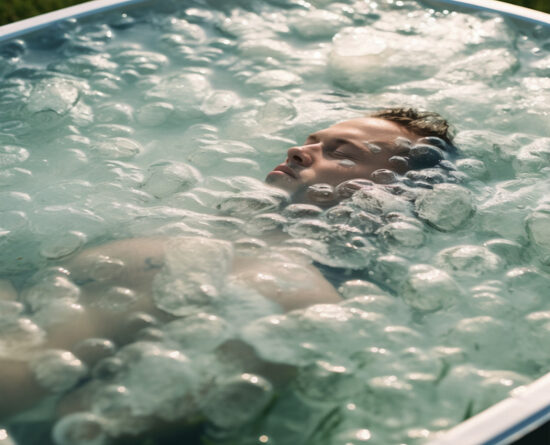Forget the wellness influencers and the vague promises of “mental toughness.” The emerging science behind using cold water immersion—whether ice baths, cold plunges, or cold water swimming—for depression is far more specific and compelling. This isn’t just about “feeling good.” It’s about forcibly correcting a dysregulated nervous system and stimulating a powerful neurochemical cascade that directly addresses several biological roots of depression..
Below, we break down the core mechanisms that make cold exposure such a fascinating, evidence-backed ally in mood regulation.
1. The Noradrenaline (Norepinephrine) Powerhouse
This is arguably the most direct and well-documented mechanism.
- The Problem in Depression: A central feature of many forms of depression is a deficiency in key neurotransmitters, particularly norepinephrine (also called noradrenaline). This isn’t just the “adrenaline” hormone; in the brain, it’s crucial for attention, focus, alertness, and motivation. A lack of it contributes directly to the brain fog, lethargy, and anhedonia (inability to feel pleasure) that characterize a depressive episode.
- The Cold Plunge Effect: Now, imagine your body being suddenly submerged in water colder than 15°C (59°F). Within seconds, your nervous system interprets this as a serious—but controlled—threat. To help you survive, it releases a massive wave of norepinephrine into both the bloodstream and the brain.
A landmark study published in the journal Neuropharmacology found that repeated cold water immersion led to a 250% increase in plasma norepinephrine levels. This isn’t a minor boost; it’s a flood. For a brain struggling with a deficit, this provides a direct, natural, and potent pharmacological effect, enhancing clarity and drive in a way that mirrors some antidepressant mechanisms, but almost instantaneously. In other words, cold plunges provide an immediate, natural boost to one of the very systems that antidepressants aim to restore—except the results are felt within minutes instead of weeks.
2. The Vagus Nerve Reset and Autonomic Nervous System Rebalancing
- The Problem in Depression: The Autonomic Nervous System (ANS), which controls involuntary functions, is often out of balance in depressed individuals. They tend to be stuck in a chronic “fight-or-flight” (sympathetic) state, with an underactive “rest-and-digest” (parasympathetic) state, governed by the vagus nerve. This leads to elevated cortisol, a higher resting heart rate, poor sleep, and a constant feeling of being on edge, even amidst the numbness.
- The Cold Plunge Effect: While the initial plunge is a massive sympathetic jolt, the adaptation to the cold and the period immediately after are a powerful vagus nerve workout. The body is forced to regulate itself against the extreme stressor. Consistent cold exposure has been shown to increase vagal tone—the measure of the vagus nerve’s activity. Higher vagal tone is strongly associated with better emotional regulation, lower inflammation, and a greater ability to calm down after a stressor. It effectively teaches a dysregulated nervous system how to return to baseline.
Research on human physiological responses to immersion in water at different temperatures confirms this parasympathetic rebound. Over time, consistent cold exposure can help restore the natural rhythm between stress and relaxation—something depression often disrupts. In short, it trains your nervous system to find balance again.
3. The Endogenous Opioid and Endocannabinoid Release
Anyone living with depression knows the hollow feeling of emotional numbness—when even pleasant experiences fail to register. This happens when the brain’s reward circuits are underactive.
Cold immersion acts as a full-body wake-up call. The intense stress prompts the release of endorphins (the body’s natural opioids) and endocannabinoids, which lift mood and blunt pain. This internal cocktail is responsible for the post-plunge euphoria many people describe—similar to the runner’s high, but often stronger and longer lasting.
It’s not a placebo. It’s your biology responding to controlled stress in a profoundly restorative way.
Case Studies and Clinical Application
While still in its early stages of clinical research, cold therapy’s potential in mental health is attracting serious scientific attention.
- The “Ice Man” Protocol: The most well-known example comes from the collaboration between Wim Hof and academic researchers at Radboud University. A randomized controlled trial demonstrated that healthy volunteers trained in the Wim Hof Method (which combines breathing techniques, cold exposure, and meditation) could voluntarily influence their autonomic nervous system and mount a reduced inflammatory response. While not a depression study per se, the ability to consciously suppress the inflammatory response is highly relevant, given the inflammatory theory of depression.
- Depression-Specific Anecdotes and Emerging Trials: There are numerous anecdotal reports from clinicians and patients using controlled cold exposure as an adjunct to therapy. For instance, Dr. Andrew Huberman, a neuroscientist at Stanford, frequently details the precise protocols (e.g., 11 minutes per week spread over sessions, at a temperature that feels uncomfortably cold but safe) that can reliably induce the norepinephrine and dopamine increases discussed above. Formal clinical trials are still in their early stages but are growing, focusing on using cold water immersion as a non-pharmacological intervention for Major Depressive Disorder.
Practical Guidelines for Using Cold Plunges Against Depression
If you’re considering this as a supportive practice, remember: it’s about consistency and control, not endurance or shock value.
- Controlled Exposure: Starting with tolerable cold showers (30-60 seconds at the end of a warm shower).
- Progression: Moving to full ice baths or cold plunges, with water temperatures between 10-15°C (50-59°F).
- Duration: Aiming for 2-4 minutes of immersion, focusing on controlled breathing to manage the initial shock.
- Consistency: Performing the practice 3-5 times per week to build the cumulative neurochemical and autonomic nervous system benefits.
- Focus on breathing: Slow, deliberate breaths help regulate your response and signal safety to your nervous system.
Conclusion
Scientifically, cold water immersion is not a “mind over matter” trick. It is a potent physiological stimulus that directly targets several core biological underpinnings of depression: neurotransmitter deficiency (norepinephrine), autonomic nervous system dysregulation (vagal tone), and inflammation. By forcibly correcting these systems, it provides a unique, drug-free tool that can alleviate symptoms and restore a degree of neurochemical and autonomic balance that depression strips away.
Delve deeper into the effects of cold exposure on depression in our guide on cold plunge depression benefits.
Additional Resources
- “Voluntary activation of the sympathetic nervous system and attenuation of the innate immune response in humans” [PNAS (2014)]
- “The effect of acute and repeated exposure to cold on central noradrenaline neurons in the rat” [Neuropharmacology] – This is a foundational animal study, but the principle holds in human physiology.












Leave a Reply